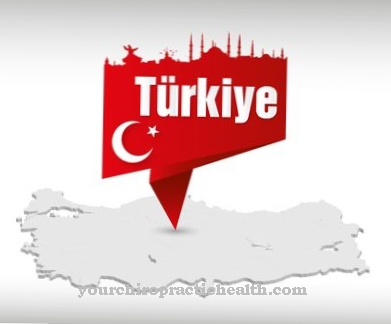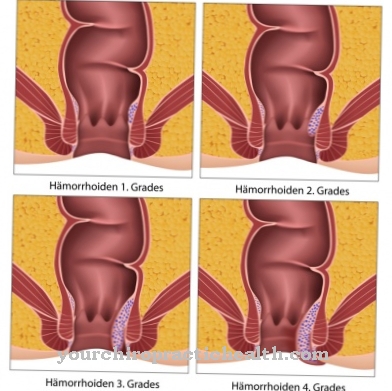In the Orbital phlegmon it is an eye disease to be treated by emergency medicine. If left untreated, orbital phlegmon can be fatal.
What is an orbital phlegmon?

© Vanessa - stock.adobe.com
The Orbital phlegmon is an inflammatory disease of the eye socket. The name of the disease is derived, among other things, from the medical name for eye socket (orbit).
Children in particular suffer from the comparatively rare but severe orbital phlegmon. In many cases orbital phlegmon is accompanied by a strong feeling of illness, which is expressed, among other things, by fever. Other symptoms of orbital phlegmon include, for example, severe pain in the affected eye and pronounced swelling of the conjunctiva.
Due to pain and swelling of the conjunctiva in the context of an orbital phlegmon, the mobility of the affected eyeball is usually restricted. Other symptoms of orbital phlegmon in various patients include visual disturbances; these can be expressed, for example, by blurred vision or the impression of double vision. Usually, an orbital phlegmon is considered a medical emergency.
causes
A Orbital phlegmon is usually caused by an infection with bacteria (often streptococci).
Possible factors that can cause or promote orbital phlegmon are diverse and vary depending on the patient in question. One of the triggers for orbital phlegmon is often a previous inflammation of the paranasal sinuses (also known as sinusitis in medicine).
Sepsis caused by bacteria (often also called blood poisoning in the vernacular) can cause orbital phlegmon. The bacteria responsible for sepsis spread through the bloodstream and reach the eye socket, where they cause inflammatory processes that are characteristic of orbital phlegmon.
Finally, external injuries to the eye are also possible causes of orbital phlegmon; Corresponding injuries can be caused, for example, by the penetration of foreign bodies.
Symptoms, ailments & signs
The orbital phlegmon is characterized by a severe course. Characteristic symptoms are swelling of the conjunctiva (chemosis), eyelid swelling, reddening of the conjunctiva due to hyperemia, protrusion of the eyeballs and reduced mobility of the affected eyes. In addition, the patient suffers from severe eye pain, loss of vision and fever.
Another symptom is double vision. The loss of vision can lead to blindness. Without treatment, there is a risk of serious complications, some of which can even be fatal. The infection can spread to the neighboring areas of the eyes or even over the entire body. Subsequent diseases such as cavernous sinus thrombosis, meningitis (meningitis) or brain abscesses may develop.
Cavernous sinus thrombosis is a life-threatening complication that, in addition to the symptoms of the eyes, presents with chills, fever, nausea and vomiting. In addition, there is severe headache, abnormal sleepiness, numbness of the face and seizures.
Death can occur as a result of cerebral haemorrhage or the spread of bacteria via the bloodstream (sepsis). Meningitis is also characterized by similar symptoms. A brain abscess is in turn characterized by severe headaches, neck stiffness, impaired consciousness and signs of intracranial pressure.
After all, all of these diseases can lead to sepsis, which is an extremely life-threatening condition. Sepsis manifests itself as a very high fever, chills, rapid breathing, impaired consciousness and often ends in fatal circulatory shock.
Diagnosis & course
Since the suspicion of a Orbital phlegmon As a medical emergency requires immediate hospitalization in most cases, diagnostic examinations are often carried out as part of the inpatient setting.
With the help of blood tests, the so-called inflammation parameters (various laboratory values that indicate inflammation in the organism) of an affected person can be determined. Computed tomography (CT) can also help confirm the suspected diagnosis of orbital phlegmon.
Symptoms of orbital phlegmon are usually sudden. As a medical emergency, orbital phlegmon is treated, among other things, because the disease leads to death within a few weeks in an average of more than half of the patients if not treated appropriately. In the majority of those affected, failure to treat orbital phlegmon leads to blindness in the eye affected by the disease. With early medical care, orbital phlegmon shows good chances of recovery.
Complications
In the worst case, orbital phlegmon can result in death of the person concerned. For this reason, this disease needs emergency medical treatment to avoid further complications directly. Those affected primarily suffer from severe swelling directly on the eye. This causes the patient's eyelids and conjunctiva to swell, leading to various visual problems.
Those affected also suffer from double vision or veiled vision and thus significant restrictions in everyday life. There is also eye pain and patients have a high fever. If the disease is not treated early, the patient can become completely blind, which is usually irreversible.
Furthermore, without treatment, the meninges become inflamed, which can ultimately lead to death if left untreated. Inflammations and infections in the nose and mouth can also occur. There are no complications with the treatment itself. With the help of antibiotics, the symptoms can usually be alleviated and the disease can be combated. A positive course of the disease usually occurs when the disease is treated early.
When should you go to the doctor?
If there are signs of inflammation of the eye socket called orbital phlegmon, it is imperative to see a doctor immediately. Without expert medical treatment, this eye disease can be fatal. Since orbital inflammation affects children in particular, more caution is required with all diseases affecting the eyes. Orbital phlegmon, however, occurs relatively rarely.
Since several severe inflammation triggers are possible causes of an orbital phlegmon, immediate action is necessary. The triggers for orbital phlegmon are streptococci, spread sinusitis germs or blood poisoning (sepsis). Penetrating foreign bodies can also trigger orbital phlegmon. These triggers are not to be trifled with because of the possible health consequences.
Because the symptoms of orbital phlegmon are usually severe, they are often easily recognizable. The drama of the orbital phlegmon can be guessed by the child's parents based on the symptoms. However, small children cannot always express how severe the pain is.
Since orbital phlegmon is considered a medical emergency, an emergency doctor should be notified immediately if there are signs such as severe conjunctival swelling, restricted mobility of the eyeball or fever. If necessary, those affected should take their child to a clinic emergency room or an eye clinic. With children, it's better to see a doctor once too often than once too little.
Treatment & Therapy
The professional treatment of the Orbital phlegmon takes place stationary. Particularly in children who are affected by orbital phlegmon, intensive medical monitoring may be necessary depending on the severity of the symptoms. An early start of therapy has a decisive influence on the success of the therapy.
An important treatment component in the therapy of orbital phlegmon includes the rapid administration of antibiotics (active ingredients to fight bacteria). The medication is often administered intravenously (the active ingredient is injected into a patient's vein) so that appropriate antibiotics can quickly reach the eye socket via the bloodstream.
In some cases, surgical treatment of the orbital phlegmon may be required. Corresponding surgical interventions are mainly carried out in patients with a developed abscess (an encapsulated collection of pus) on the eye. If there is no operation here, there is a risk that the person affected will suffer from meningitis (meningitis) as a result.
If the orbitaphlegmon is based on sinusitis in individual cases, surgical treatment of the corresponding sinuses may be medically necessary.
Outlook & forecast
Orbital phlegmon is a dangerous infectious disease of the eye socket. The prognosis is only positive if the therapy starts quickly. The acute illness is visually noticeable. The affected eye is very painful. It is noticeably reddened. There is therefore a high probability that those affected will promptly visit an ophthalmologist or an outpatient clinic.
Sometimes both eyes are affected by orbital phlegmon. In addition, there are often severe side effects associated with this infection.Those affected have a strong feeling of illness. You have chills or a severe headache. Sometimes fever, nausea, and vomiting occur. In other cases, convulsions, delirium, or a coma can occur. The affected eye is very red and swollen shut.
Orbital phlegmon is a medical emergency. This is caused by a severe infection behind the eyeball. The longer it takes for the patient to come to an emergency ambulance, the worse the prognosis. There is a risk of spreading thrombophlebitis. This can result in a cavernous sinus thrombosis.
The early treatment with antibiotics and the sanitation of the sinuses are important immediate measures. However, these require that the diagnosis be corrected immediately. Orbital phlegmon is particularly common in tropical countries. Unfortunately, fast medical care is not guaranteed everywhere.
prevention
Consequential damage due to Orbital phlegmon is to be prevented primarily through early therapy. Injuries to the eye, which can lead to orbital phlegmon, can only be prevented to a limited extent; However, appropriate protective equipment can be important for people with an increased risk of injury at work or in their free time. Finally, doctors recommend early visits to the doctor if you have a sinus infection or possible blood poisoning in order to limit the risk of a subsequent orbital phlegmon.
Aftercare
After diagnosing and treating orbital phlegmon, those affected need to protect their eye sockets from influences such as bacteria and wind. The person concerned should avoid exercise to prevent the orbital phlegmon from spreading to other regions of the body. People who suffer from serious illnesses or an immune deficiency are particularly susceptible to secondary infections. Particular caution applies here.
Wearing an eye patch can also protect against a second infection. In addition, the eye patch can protect those affected from the spread of the disease and thus infect other parts of the body. This can prevent further symptoms from occurring. Sufferers should find the exact cause of the disease.
For example, people who frequently suffer from barley grains as a result of their job and who are thus ill with orbital phlegmon should consider changing jobs. If the disease is so advanced that both eyes become blind, a psychologist should be consulted.
This can help sufferers to cope with the loss of vision and to process it appropriately. In the case of sick children, parents should make sure that the child does not touch their eyes with their hands. Above all, strict personal hygiene and avoiding particularly sweet, sour and spicy drinks and foods.
You can do that yourself
If orbital phlegmon is suspected, the doctor should be consulted. After the diagnosis, it is important to protect the eye socket from external influences such as wind and bacteria. Treatment with antibiotics can be supported by rest. The patient should not exercise for the first few days and make sure that the orbital phlegmon does not spread to other parts of the body.
People with an existing immune deficiency or other serious illnesses that favor secondary infections are particularly at risk. If necessary, it can also be useful to wear an eye patch. This prevents the infected area from becoming inflamed and causing further discomfort. Finally, it is important to determine the cause of the suffering. People who repeatedly suffer from orbital phlegmon after professional contact with barley grains must consider changing jobs.
If the course is severe with blindness in one or both eyes, psychological counseling is also useful. The patient can also exchange ideas with other sufferers in order to cope with the loss of vision. Parents of affected children should take care that the child does not touch the inflamed eye. Strict personal hygiene and, if necessary, a change in diet apply. Particularly spicy, sour or sweet foods and drinks should be avoided.


.jpg)





















.jpg)



